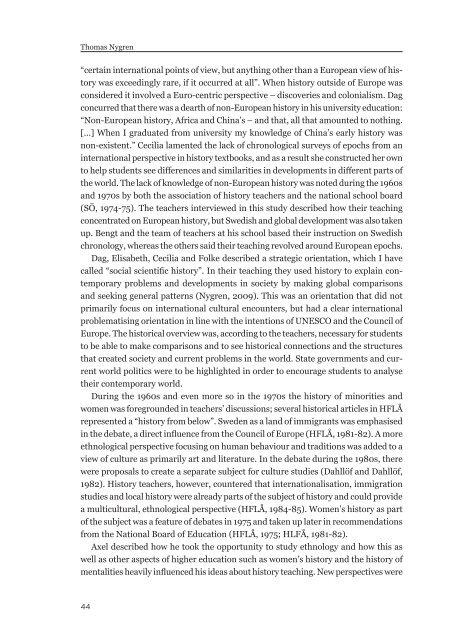Download issue - Umeå universitet
Download issue - Umeå universitet
Download issue - Umeå universitet
Create successful ePaper yourself
Turn your PDF publications into a flip-book with our unique Google optimized e-Paper software.
Thomas Nygren<br />
“certain international points of view, but anything other than a European view of history<br />
was exceedingly rare, if it occurred at all”. When history outside of Europe was<br />
considered it involved a Euro-centric perspective – discoveries and colonialism. Dag<br />
concurred that there was a dearth of non-European history in his university education:<br />
“Non-European history, Africa and China’s – and that, all that amounted to nothing.<br />
[…] When I graduated from university my knowledge of China’s early history was<br />
non-existent.” Cecilia lamented the lack of chronological surveys of epochs from an<br />
international perspective in history textbooks, and as a result she constructed her own<br />
to help students see differences and similarities in developments in different parts of<br />
the world. The lack of knowledge of non-European history was noted during the 1960s<br />
and 1970s by both the association of history teachers and the national school board<br />
(SÖ, 1974-75). The teachers interviewed in this study described how their teaching<br />
concentrated on European history, but Swedish and global development was also taken<br />
up. Bengt and the team of teachers at his school based their instruction on Swedish<br />
chronology, whereas the others said their teaching revolved around European epochs.<br />
Dag, Elisabeth, Cecilia and Folke described a strategic orientation, which I have<br />
called “social scientific history”. In their teaching they used history to explain contemporary<br />
problems and developments in society by making global comparisons<br />
and seeking general patterns (Nygren, 2009). This was an orientation that did not<br />
primarily focus on international cultural encounters, but had a clear international<br />
problematising orientation in line with the intentions of UNESCO and the Council of<br />
Europe. The historical overview was, according to the teachers, necessary for students<br />
to be able to make comparisons and to see historical connections and the structures<br />
that created society and current problems in the world. State governments and current<br />
world politics were to be highlighted in order to encourage students to analyse<br />
their contemporary world.<br />
During the 1960s and even more so in the 1970s the history of minorities and<br />
women was foregrounded in teachers’ discussions; several historical articles in HFLÅ<br />
represented a “history from below”. Sweden as a land of immigrants was emphasised<br />
in the debate, a direct influence from the Council of Europe (HFLÅ, 1981-82). A more<br />
ethnological perspective focusing on human behaviour and traditions was added to a<br />
view of culture as primarily art and literature. In the debate during the 1980s, there<br />
were proposals to create a separate subject for culture studies (Dahllöf and Dahllöf,<br />
1982). History teachers, however, countered that internationalisation, immigration<br />
studies and local history were already parts of the subject of history and could provide<br />
a multicultural, ethnological perspective (HFLÅ, 1984-85). Women’s history as part<br />
of the subject was a feature of debates in 1975 and taken up later in recommendations<br />
from the National Board of Education (HFLÅ, 1975; HLFÅ, 1981-82).<br />
Axel described how he took the opportunity to study ethnology and how this as<br />
well as other aspects of higher education such as women’s history and the history of<br />
mentalities heavily influenced his ideas about history teaching. New perspectives were<br />
44

















